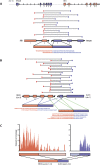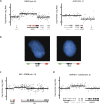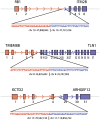Integrative analysis of the melanoma transcriptome
- PMID: 20179022
- PMCID: PMC2847744
- DOI: 10.1101/gr.103697.109
Integrative analysis of the melanoma transcriptome
Abstract
Global studies of transcript structure and abundance in cancer cells enable the systematic discovery of aberrations that contribute to carcinogenesis, including gene fusions, alternative splice isoforms, and somatic mutations. We developed a systematic approach to characterize the spectrum of cancer-associated mRNA alterations through integration of transcriptomic and structural genomic data, and we applied this approach to generate new insights into melanoma biology. Using paired-end massively parallel sequencing of cDNA (RNA-seq) together with analyses of high-resolution chromosomal copy number data, we identified 11 novel melanoma gene fusions produced by underlying genomic rearrangements, as well as 12 novel readthrough transcripts. We mapped these chimeric transcripts to base-pair resolution and traced them to their genomic origins using matched chromosomal copy number information. We also used these data to discover and validate base-pair mutations that accumulated in these melanomas, revealing a surprisingly high rate of somatic mutation and lending support to the notion that point mutations constitute the major driver of melanoma progression. Taken together, these results may indicate new avenues for target discovery in melanoma, while also providing a template for large-scale transcriptome studies across many tumor types.
Figures






Similar articles
-
Genomic and Transcriptomic Analysis Reveals Incremental Disruption of Key Signaling Pathways during Melanoma Evolution.Cancer Cell. 2018 Jul 9;34(1):45-55.e4. doi: 10.1016/j.ccell.2018.06.005. Cancer Cell. 2018. PMID: 29990500 Free PMC article.
-
A Transcriptome-Wide Isoform Landscape of Melanocytic Nevi and Primary Melanomas Identifies Gene Isoforms Associated with Malignancy.Int J Mol Sci. 2021 Jul 2;22(13):7165. doi: 10.3390/ijms22137165. Int J Mol Sci. 2021. PMID: 34281234 Free PMC article.
-
Integrative genome comparison of primary and metastatic melanomas.PLoS One. 2010 May 24;5(5):e10770. doi: 10.1371/journal.pone.0010770. PLoS One. 2010. PMID: 20520718 Free PMC article.
-
Melanocytic Skin Neoplasms: What Lesson From Genomic Aberrations?Am J Dermatopathol. 2019 Sep;41(9):623-629. doi: 10.1097/DAD.0000000000001341. Am J Dermatopathol. 2019. PMID: 31433323 Review.
-
Applications of genomics in melanoma oncogene discovery.Hematol Oncol Clin North Am. 2009 Jun;23(3):397-414, vii. doi: 10.1016/j.hoc.2009.03.005. Hematol Oncol Clin North Am. 2009. PMID: 19464593 Free PMC article. Review.
Cited by
-
De novo assembly and characterization of bark transcriptome using Illumina sequencing and development of EST-SSR markers in rubber tree (Hevea brasiliensis Muell. Arg.).BMC Genomics. 2012 May 18;13:192. doi: 10.1186/1471-2164-13-192. BMC Genomics. 2012. PMID: 22607098 Free PMC article.
-
Reanalysis of RNA-sequencing data reveals several additional fusion genes with multiple isoforms.PLoS One. 2012;7(10):e48745. doi: 10.1371/journal.pone.0048745. Epub 2012 Oct 31. PLoS One. 2012. PMID: 23119097 Free PMC article.
-
MelanomaDB: A Web Tool for Integrative Analysis of Melanoma Genomic Information to Identify Disease-Associated Molecular Pathways.Front Oncol. 2013 Jul 16;3:184. doi: 10.3389/fonc.2013.00184. eCollection 2013. Front Oncol. 2013. PMID: 23875173 Free PMC article.
-
Transcriptome profiling of the cancer, adjacent non-tumor and distant normal tissues from a colorectal cancer patient by deep sequencing.PLoS One. 2012;7(8):e41001. doi: 10.1371/journal.pone.0041001. Epub 2012 Aug 8. PLoS One. 2012. PMID: 22905095 Free PMC article.
-
deFuse: an algorithm for gene fusion discovery in tumor RNA-Seq data.PLoS Comput Biol. 2011 May;7(5):e1001138. doi: 10.1371/journal.pcbi.1001138. Epub 2011 May 19. PLoS Comput Biol. 2011. PMID: 21625565 Free PMC article.
References
-
- Albert TJ, Molla MN, Muzny DM, Nazareth L, Wheeler D, Song X, Richmond TA, Middle CM, Rodesch MJ, Packard CJ, et al. Direct selection of human genomic loci by microarray hybridization. Nat Methods. 2007;4:903–905. - PubMed
-
- Blacker D, Wilcox MA, Laird NM, Rodes L, Horvath SM, Go RC, Perry R, Watson B, Jr, Bassett SS, McInnis MG, et al. Alpha-2 macroglobulin is genetically associated with Alzheimer disease. Nat Genet. 1998;19:357–360. - PubMed
Publication types
MeSH terms
Substances
Grants and funding
LinkOut - more resources
Full Text Sources
Other Literature Sources
Medical
Molecular Biology Databases
